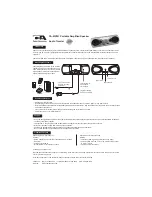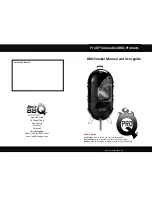
Attach both logo caps as shown in Figure 8
after tightening and securing the speaker.
Step 3:
Wire the Speaker
Connect the wires to the speaker at the
back terminal plate observing the polarity
of the connections. The push-terminals
accept banana connector plugs.
Step 4:
Secure the Seismic
T
a
b
Connection P
oint
The rear of the enclosure includes an eye-
bolt for connection to a seismic restraint.
Connect it to a properly rated hardware fit-
ting that is securely installed independent-
ly of the SAM™ bracket. Even if your local
construction code does not require the
installation of secondary support, its use is
highly recommended for further security.
Step 5:
T
est System Operation
After all connections are made, test the
complete system operation. The Trouble-
shooting Table on the next page will assist
in locating many speaker-related problems.
EV logo cap
(large)
EV logo cap
(small)
Figure 8:
Attach logo caps
Connect seismic
secur
ity cab
le
Figure 9:
Secure seismic secur
ity cab
le
P
ro
b
le
m
P
ossib
le Cause(s)
Action
1.
No sound
Amplifier
Connect a kno
wn w
o
rking test speak
er to the amplifier
outputs
.
If there is no sound, chec
k that all the elec-
tronics are on, the signal routing is correct, the source
is activ
e
, the v
o
lume is tur
ned up
, and so on.
Correct/
repair/replace as necessar
y.
If there is sound, the
prob
lem is in the wir
ing.
W
ir
in
g
V
e
rify that y
ou ha
ve
connected the correct wire pairs to
the amplifier
.
Pla
y something at lo
w le
vel through the
amplifier (f
or e
xample
, from a CD pla
y
er or tuner).
Connect the test speak
er in par
allel with the malfunc-
tioning line
.
If the sound has gone or is v
e
ry
w
eak, the
line has a shor
t in it (possib
ly a se
vere scr
ape
, pinch,
or staple puncture).
If the sound le
vel is nor
mal, the
wire is open (possib
ly a cut wire or a missed connec-
tion).
Using the test speak
er
, mo
ve
do
wn the line and
test each connection/junction until y
ou find the prob
lem
and correct it.
Obser
ve
proper polar
ity
.
2.
P
oor lo
w-
Speak
ers wired
When tw
o speak
ers are connected out of polar
ity
frequenc
y
out-of-polar
ity
(out of phase), the lo
w frequencies will cancel each
response
other acoustically
.
Carefully obser
ve
the wire mar
kings
or tr
acers on y
our speak
er wires
.V
er
ify that the ampli-
fier (+) ter
minal is connected to the red speak
er ter
mi-
nals and the amplifier (–) ter
minal is connected to all
the b
lac
k speak
er ter
minals
.
Improper
ly wired
Using a test speak
er as descr
ibed abo
v
e
, v
e
rify that
subw
oof
er panel
all amplifier and speak
er wires are connected to their
proper ter
minals with the correct polar
ity
.
Re
ver
sing
just one set of amplifier wires can cut out all bass
output fr
om the subw
oof
er
.
3
.
Intermittent output
F
aulty
connection
Chec
k all connections at amplifier and speak
ers to
suc
h as crac
kling
ensure the
y are clean and tight.
If the prob
lem persists
,
or distor
tion
it ma
y be in the amplifier or wir
ing.
See no
.
1
abo
ve
.
4
.
Constant noise
Def
ectiv
e amplifier
If the noise is present b
ut no prog
ram mater
ial is
suc
h as b
uzzing,
or other electronic
pla
ying, the lik
ely cause is the signal chain in the elec-
hissing,
humming
de
vice
tronics
.
E
valuate each component as necessar
y to iso-
late the prob
lem.
P
oor system
Chec
k and correct the system g
rounding, as required.
g
rounding or
g
round loop
If these suggestions do not solv
e y
our prob
lem, contact y
our nearest Electro-V
oice dealer or
Electro-V
oice distr
ib
utor
.
T
roub
leshooting T
a
b
le






















